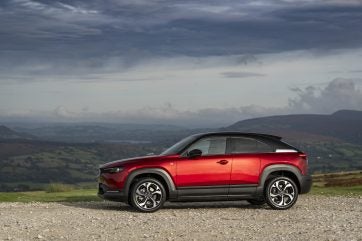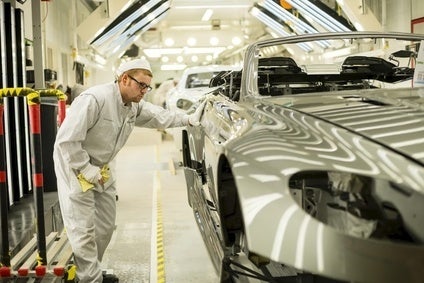
A lot of people who love cars have been sniffy about the MX-30 eSkyactiv R-EV (and if ever a car needed a better and shorter name, this is it: why not RX-30?). I myself was not too impressed by the idea of the first MX-5/Miata all those decades ago but soon changed my mind after driving one.
Finally, a new rotary-powered sports car?
The final-shape RX-7 was a quirky-beautiful thing, the RX-8 perhaps less so but I am happy that it existed, keeping the Wankel engine alive. Rumours of an RX-9 come and go, Mazda continues to excite then disappoint with impossibly gorgeous rotary-powered show cars.
The Iconic SP (pics: here) – a world debut at the Tokyo motor show four months ago – is merely the latest tease. Sadly, the cycle continues, the official statement is always the same: “we will investigate a business case”. Then, “the time is not right, we will continue to work on the engine”, and so on. In this case it is a bi-rotor motor, acting as a back-up generator, the SP being electric.
If you love Mazda but feel frustrated by its policy of no new rotary sports car, do as I do: celebrate the fact that the company is at least making one Wankel-powered vehicle.
Eccentricity and an expansion of earnings
How well do you really know your competitors?
Access the most comprehensive Company Profiles on the market, powered by GlobalData. Save hours of research. Gain competitive edge.

Thank you!
Your download email will arrive shortly
Not ready to buy yet? Download a free sample
We are confident about the unique quality of our Company Profiles. However, we want you to make the most beneficial decision for your business, so we offer a free sample that you can download by submitting the below form
By GlobalDataIt is a curious thing, the MX-30 R-EV. This C segment SUV is one of the world’s most unusual vehicles. In some ways, its maker keeps evolving itself into the company for enthusiasts. Especially now that Alpine, BMW, Dodge, Ford, Jaguar, MG, VW and others have either been taken down the road of electric-and-or-profit-over-all-else, or are trying to get there.
Mazda has become a fabulously eccentric outlier. But even better, it has found a way to pull in some big margins at the same time. Others might wake up to this. Neither Citroën nor Alfa Romeo nor Lancia will be allowed to flourish with IC-engine technology. Meanwhile both Honda and Porsche are also going (almost) all-in on heavier and heavier battery cars jammed with ever more screens and digital features.
Yes, there are a lot of people who want tech-to-the-max models. There are also millions of others who long for simpler, lighter vehicles. Such as almost every Subaru in the USA or Dacia in Europe (n.b. sales are soaring for both) or the MX-5. It is too wonderful a thought to hope that the next Miata might be both back-to-basics and as beautiful as the Iconic SP. Or that its powertrain could be the same as the one in the concept.
Emissions – still an issue with a rotary engine?
The MX-30 R-EV is marketed as an electric vehicle, and in theory yes it is, yet the tiny rotor is fired into life often, or at least it was whilst I tried one such example recently. If that long-term issue with Wankel engines has been greatly improved, namely relatively high emissions, economy remains shall we say, sub-optimal. The car which spent a week in my hands returned just over 30 mpg but to be fair to Mazda, the software didn’t activate petrol power on every journey. And the official CO2 average is a mere 21 grams per kilometre.
A conventional internal combustion vehicle sends power and torque to one or more axles via a gearbox. In the R-EV, energy instead travels directly to either the battery or the inverter. The tiny rotor emits a bit of a buzzy sound though it is in no way unpleasant aurally, and the absence of vibration is a boon too. There is no chance you will be reminded of former RX models, let alone the when cicadas-guzzle-Red-Bull din of a racing rotary. And yet it does please the ears.
Quirky and (high) quality
More reasons to think of Mazda as the newly-quirkiest of all car makers abound when you open an MX-30 R-EV door. And whilst there are five of them, only two plus the tailgate are conventional. Those for back seat passengers cannot be accessed without the relevant front one open, each of which, incidentally, swings to almost ninety degrees.
Hinged rearwards, the passenger portes are smaller than the fronts, in the same way as they were in the long-gone RX-8. There is way more headroom than in that model and this can be said for all five potential occupants.
Cork: a tribute to the history of Mazda
The usual Mazda high-quality aura is present in the R-EV with some at first perhaps strange material details, cork being one such. This is to do with the history of the company and one of the items manufactured by the Japanese firm many decades ago.
About the only thing I would chuck away – and it would have to go immediately – is an especially horrid automatic transmission lever. Why do OEMs continue to have their suppliers redesign things which used to work perfectly, the result so often being worse? It is a mystery. At least there are lots of lovely real twirly or pushy controls and the touchscreen too is a decent (i.e. not too big) size.
As it was fairly chilly during a couple of mornings, I activated the steering wheel heating and here discovered something odd. In the quest to maximise EV range, your hands are toasted only at the ten-to-two position. That might seem clever to Mazda but in fact I kept the heat going far longer than I do in other cars as the rest of the wheel was cold when parking. Please let us have whole-circumference warmth and energy will be saved.
How far will it go on stored ions?
That oddity made me extra curious about the range of the MX-30, realising that Mazda must have been concerned. And so it was that this EV used almost three kilowatts per mile. The car told me it averaged 2.9 miles per kW but I do not know what point nine of an imperial unit would be. Does anyone? There was a separate readout for MPG and this showed 32 on average, while another said an indicated 100 per cent charge would give me 30 miles. And yet the official number is in the 50s. No, I don’t understand that either.
The R-EV steers nicely, rides well for something which does not have an especially long wheelbase or heavy battery, leans a bit when driven with vim, and sadly is not particularly rapid. And yet it is a likeable thing this car, and I am thrilled that it exists. Almost as much as I am knowing about the new family of highly efficient inline petrol and diesel six-cylinder engines for the company’s larger SUVs. And maybe some cars too, such as a rumoured replacement for the 6, the present generation of which has been around since 2012.
Ever more EVs says Moro
Masahiro Moro said as recently as December that he sees seven or eight EVs in the line-up by decade-end. These might by then account for somewhere between 25 and 40 per cent of worldwide sales, Mazda’s chief executive noted.
Who can say what the market for electric cars might look like even in the next quarter? This is one smart OEM, driven by what will be an inherent company-wide fear of falling into financial ruin by placing the majority of its powertrain bets mainly on one thing. Especially when that one thing is EVs.
There was near-bankruptcy for Mazda half a century ago due mainly to the Wankel engine. The firm then found itself on shaky ground again in the late 1990s (e.g. masses spent on Amati, an aborted luxury brand) and once more after Ford dumped its significant minority stake during the 2000s. Now, guided quietly by its giant partner TMC, there are various Toyota-Mazda alliances where these make the most sense. One of which is a determination not to throw away liquid-fuel engine manufacturing and with it, a superbly skilled workforce. A smart OEM indeed.
What of the future of the rotary engine then? One year on from the debut of the MX-30 R-EV at the Brussels motor show in January 2023, Mazda displayed the Iconic SP for a second time at another new cars expo. Its CEO spoke openly at this event about what could be ahead. Moro-san told reporters at the Tokyo Auto Salon that a dedicated team of rotary engine engineers would become an official division as at 1 February. He especially noted the challenges of the carbon-neutral era. Which sounds a lot like so-called ’green’ hydrogen and/or e-fuels.
Conclusion
This highly unusual and appealing model has only one real fault, namely that it looks just like the older MX-30. A shame that, when it could have been styled to stand out. Even giving it some sexy rotor-shaped alloy wheels or better still, a low-rood fastback body too.
How can Mazda be the same company which creates or commissions jaw-dropping concepts but then gives us a truly clever powertrain technology in an almost vanilla wrapper? Albeit with the various quirks noted above.
I loved my week with the R-EV. I just wished someone, anyone, would have noticed it. Nobody did. And that was a great shame as it is a fantastic piece of advanced engineering.
The Mazda MX-30 e-Skyactiv R-EV has a top speed of just 87 mph, accelerates from 0-62 mph in 9.1 seconds, is fitted with a 17.8 kWh battery and has an official range of 53 miles in EV mode. Pricing starts at GBP34,750.





